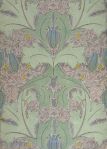Jenkins attends an Indian embassy party. “The huge saloons, built at the turn of the century, were done up in sage green, the style of decoration displaying a nostalgic leaning toward Art Nouveau, a period always sympathetic to Asian taste.” [MP 204-205/199]
The term Art Nouveau was introduced in the 1890s in a Belgian journal, L’Art Moderne. The style prospered in France, propelled in part by a gallery, L’Art Nouveau, owned by Siegfried Bing. The movement championed flowing designs based on shapes derived from plants and vines. Think of the iron-work entries of the Paris Metro and the graphics used to advertise that subway system. The French vogue for japonisme is seen in many of the works. William Morris and the Arts and Crafts Movement influenced British Art Nouveau.
We can imagine the wallpaper shown at left in the embassy rooms. C.F.A. Voysey (1857-1941) was an English architect and designer who was particularly well known for his wallpaper. The Victoria and Albert Museum has a fine collection of his work. In 1896 The Studio, a magazine that championed Art Nouveau and Arts and Crafts, proclaimed, “Now a ‘Voysey wall-paper’ sounds almost as familiar as a ‘Morris chintz’ or a ‘Liberty silk’.” ( Studio International, vol. 7, p. 209 ) Exactly which works qualify as Art Nouveau is debated; some critics dismiss Voysey’s work as too “Art Nouveau artsy” and others separate his pieces from the Art Nouveau movement.
